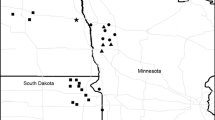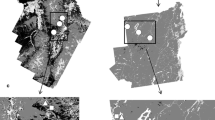Abstract
We report on the development and preliminary application of a songbird community-based index of biotic integrity. The bird community index (BCI) sorts bird species found at sample sites into a series of values representing the proportional species richness of 20 behavioral and physiological response guilds. Relative proportions of specialist and generalist guilds are used to assign a composite score to each site. Scores from multiple sites indicate the overall biotic integrity of the study area. The BCI is intended to function as a landscape-scale indicator of biotic integrity, integrating conditions across large sample sites containing diverse ecological resources and intensities of human use. We developed the BCI with data from a 1994 pilot study in central Pennsylvania, then applied our preliminary index in 1995 and 1996 to independent samples of sites across the Mid-Atlantic Highlands Assessment area (MAHA). The 1995 and 1996 sample sites were selected using the probability-based sampling design of the Environmental Monitoring and Assessment Program (EMAP), and therefore represent the total land area in MAHA. Our preliminary assessment indicates that MAHA exhibits six categories of biotic integrity, and that more than 40% of the land area supports the two highest biotic integrity categories. Pending BCI refinement and incorporation of landscape and vegetation explanatory variables, the BCI will be included in a suite of indicators designed to provide an assessment of overall ecological condition in MAHA.
Similar content being viewed by others
References
Bailey, R. G.: 1980, ‘Description of the ecoregions of the United States,’ USDA Forest Service Misc. Pub. 1391, 77 pp.
Barber, M. C. (ed.): 1994, ‘The Environmental Monitoring and Assessment Program Indicator Development Strategy,’ EPA/620/R-94/022, U.S. Environmental Protection Agency, Office of Research and Development, EMAP-Center, Research Triangle Park, NC.
Blake, J. G.: 1983, ‘Trophic structure of bird communities in forest patches in east-central Illinois,’ Wilson Bulletin 95, 416–430.
Bradford, D. F., Franson, S. E., Neale, A. C., Heggem, D. T., Miller, G. R., and Cantebury, G.E.: (In press), ‘Bird species assemblages as indicators of biological integrity in Great Basin rangeland,’ Environmental Monitoring and Assessment.
Brauning, D.W. (ed.): 1992, Atlas of Breeding Birds in Pennsylvania, University of Pittsburgh Press, Pittsburgh, PA.
Brooks, R. P. and Croonquist, M. J.: 1990, ‘Wetland, habitat, and trophic response guilds for wildlife species in Pennsylvania,’ Journal of the Pennsylvania Academy of Science 64, 93–102.
Brooks, R. P., Cole, C. A., Wardrop, D. H., Bishel-Machung, L., Prosser, D. J., Campbell, D. A., and Gaudette, M. T.: 1996, ‘Wetlands, Wildlife, and Watershed Assessment Techniques for Evaluation and Restoration: Final Report for the Project: Evaluating and Implementing Watershed Approaches for Protecting Pennsylvania's Wetlands,’ Report No. 96-2, Penn State Cooperative Wetlands Center, University Park, PA. Volumes I and II.
Brooks, R. P., O'Connell, T. J., Wardrop, D. H., and Jackson, L. E.: 1997, ‘Towards a Regional Index of Biological Integrity: The Example for Forested Riparian Systems,’ Environmental Monitoring and Assessment, this volume.
Croonquist, M. J. and Brooks, R. P.: 1991, ‘Use of avian and mammalian guilds as indicators of cumulative impacts in riparian-wetland areas,’ Environmental Management 15, 701–714.
DeGraaf, R. M., Tilghman, N. G., and Anderson, S. H.: 1985, ‘Foraging guilds of North American birds,’ Environmental Management 9, 493–536.
Fore, L. S., Karr, J. R., and Wisseman, R. W.: 1996, ‘Assessing invertebrate responses to human activities: evaluating alternative approaches,’ Journal of the North American Benthological Society 15, 212–231.
Freemark, K. and Collins, B.: 1992, ‘Landscape ecology of birds breeding in temperate forest fragments,’ pages 443–454 in Ecology and Conservation of Neotropical Migrant Landbirds (J.M. Hagan III and D.W. Johnston, Eds.), Smithsonian Institution Press, Washington, D.C.
Harrison, H. H.: 1975, A Field Guide to the Birds' Nests: United States east of the Mississippi River, Houghton Mifflin Co., Boston, MA
Hunsaker, C. T. and Carpenter, D. E. (eds.): 1990, ‘Ecological Indicators for the Environmental Monitoring and Assessment Program,’ EPA/600/3-90/060. U.S. Environmental Protection Agency, Office of Research and Development, Research Triangle Park, NC.
Hutto, R. L., Pletschet, S. M., and Hendricks, P.: 1986, ‘A fixed-radius point count method for nonbreeding and breeding season use,’ Auk 103, 593–602.
Karr, J. R.: 1991, ‘Biological integrity: a long-neglected aspect of water resource management,’ Ecological Applications 1, 66–84.
Karr, J. R.: 1993, ‘Defining and assessing ecological integrity: beyond water quality,’ Environmental Toxicology and Chemistry 12, 1521–1531.
Karr, J. R. and Dudley, D. R.: 1981, ‘Ecological perspective on water quality goals,’ Environmental Management 5, 55–68.
Manuwal, D. A. and Carey, A. B.: 1991, ‘Methods for measuring populations of small, diurnal forest birds,’ Gen. Tech. Rep. PNW-GTR-278, Portland, OR: U. S. Department of Agriculture, Forest Service, Pacific Northwest Research Station, 23 p.
Minitab, Inc.: 1995, Minitab Reference Manual: Release 10Xtra, Minitab, Inc., State College, PA.
Neter, J., Wasserman, W., and Kutner, M. H.: 1990, Applied Linear Statistical Models. Richard D. Irwin, Inc., Homewood, IL.
Overton, W. S., White, D., and Stevens, D. L. Jr.: 1990, ‘Design Report for EMAP,’ EPA/600/3-91/053, U.S. Environmental Protection Agency, Office of Research and Development, Washington, DC.
Ralph, C. J., Geupel, G. R., Pyle, P., Martin, T. E., and DeSante, D. F.: 1993, ‘Handbook of field methods for monitoring landbirds,’ Gen. Tech. Rep. PSW-GTR-144. Albany, CA: Pacific Southwest Research Station, Forest Service, U. S. Department of Agriculture, 41 p.
Santner, S. J., Brauning, D. W., Schwalbe, G., and Schwalbe, P. W.: 1992, ‘Annotated List of the Birds of Pennsylvania,’ Pennsylvania Biological Survey No. 4, Ornithological Technical Committee.
Stevens, Jr., D. L. and Kincaid, T.: (In prep., 1997.) ‘Variance estimation for subpopulation parameters from samples of spatial environmental populations,’ Invited paper to be presented at the annual meeting of the American Statistical Association, Aug., 1997, and to appear in the Proceedings of the Environmental Statistics section.
Szaro, R.: 1986, ‘Guild management: an evaluation of avian guilds as a predictive tool,’ Environmental Management 10, 681–688.
Terborgh, J.: 1989, Where have all the birds gone?, Princeton University Press, Princeton, N. J.
Verner, J.: 1984, ‘The guild concept applied to management of bird populations,’ Environmental Management 8, 1–14.
Author information
Authors and Affiliations
Rights and permissions
About this article
Cite this article
O'Connell, T., Jackson, L.E. & Brooks, R.P. A Bird Community Index of Biotic Integrity for the Mid-Atlantic Highlands. Environ Monit Assess 51, 145–156 (1998). https://doi.org/10.1023/A:1005914714813
Issue Date:
DOI: https://doi.org/10.1023/A:1005914714813




